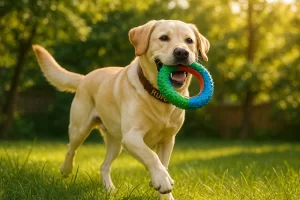As pet owners, we all want the best for our furry companions. We want them to be happy, healthy, and comfortable, and a large part of that responsibility is providing them with a nutritious diet. However, for some dogs, finding the right food can be a long and challenging journey, especially when food allergies or sensitivities are involved. Luna, a lively and energetic dog, went through this very struggle. Her journey from frustration and worry to discovering the perfect natural diet is a story that many pet owners can relate to.
The Beginning of the Struggle
Luna, a five-year-old Golden Retriever, had always been a happy and healthy dog. From the moment she was a puppy, she loved her food and would eagerly devour any meal placed in front of her. Her coat was shiny, her energy levels were high, and she was generally a picture of health. But as Luna got older, her behavior started to change. She began refusing her meals and became increasingly picky with food. At first, her owners, Sarah and David, thought it was just a phase. However, things soon escalated.
Luna’s stomach began to show signs of distress. She had episodes of vomiting and diarrhea, and her coat started to look dull and lifeless. Sarah and David took Luna to the vet, and after a thorough examination, they received the news they had been dreading: Luna had food allergies. The vet confirmed that Luna was likely allergic to some of the common ingredients in her commercial dog food, such as chicken, grains, and artificial additives.
The Turning Point
The diagnosis left Sarah and David devastated. They never imagined that something as simple as food could cause their beloved dog so much distress. Luna’s refusal to eat and her digestive issues were taking a toll on her health, and her once vibrant personality was fading. They tried various prescription diets, but Luna’s reactions continued. Her allergies seemed to persist despite the changes in her food, and they felt like they were running out of options.
“I remember feeling like we would never get it right,” Sarah recalls. “Luna had become so picky with her food, and we were just trying to find something that would work. It felt like she was never going to be comfortable again.”
It was at this point that Sarah and David decided to take matters into their own hands. They began researching natural diets for dogs, hoping to find a solution that could help Luna thrive. They read about the benefits of raw food diets, whole-food ingredients, and the importance of eliminating allergens from their dog’s diet. It was a daunting task, but they were determined to give Luna the best chance at recovery.
Transitioning to a Natural Diet
The decision to transition Luna to a natural, home-cooked diet was not made lightly. Sarah and David knew it would take time, patience, and a lot of trial and error. They consulted with a canine nutritionist to ensure they were meeting all of Luna’s nutritional needs and started by gradually introducing home-cooked meals made from whole ingredients.
Luna’s new diet consisted of lean meats like turkey and lamb, organic vegetables such as sweet potatoes, carrots, and zucchini, and a healthy mix of grains like quinoa and rice. They also included healthy fats from fish oil and coconut oil, which helped improve Luna’s coat and support her overall health. The goal was to avoid common allergens like chicken, beef, and grains, and instead focus on ingredients that were fresh, natural, and minimally processed.
The first few weeks were challenging. Luna was hesitant about the new food, and Sarah and David had to experiment with different combinations to find what she liked best. They also had to monitor her closely for any signs of adverse reactions. However, as time went on, Luna began to show improvement. Her stomach issues started to subside, her energy levels increased, and her coat became shinier and more vibrant.
The Positive Results
After a few months of feeding Luna a natural diet, the transformation was remarkable. Luna’s appetite returned, and she eagerly devoured her meals, something Sarah and David had not seen in a long time. Her digestive problems were gone, and her coat had regained its softness and shine. She was more active, playful, and, most importantly, comfortable in her own skin.
Luna’s allergies seemed to have been under control for the first time in a long while. She no longer had the constant stomach issues or the lack of energy that had once plagued her. Her health was improving every day, and Sarah and David were overjoyed to see their dog happy again.
“I can’t tell you how much of a relief it was to see Luna finally enjoy her food again,” says Sarah. “It was like watching her come back to life. Her energy levels are through the roof now, and she’s back to being the happy, playful dog we’ve always known.”
The Importance of Finding the Right Diet for Allergic Dogs
Luna’s journey underscores an important lesson for all pet owners: finding the right diet for dogs with allergies can make all the difference in their quality of life. Food allergies in dogs are more common than many people realize, and they can have a significant impact on a dog’s health and well-being. The right diet can not only alleviate symptoms but also improve a dog’s overall health, helping them live a longer and more fulfilling life.
Sarah and David learned that with determination, research, and the support of professionals, they could find a solution that worked for Luna. They now recommend a natural diet for dogs with allergies to others who are facing similar struggles.
“It’s not an easy process, but seeing the results in Luna has been so rewarding,” says David. “She’s happier, healthier, and more energetic than ever, and we couldn’t be more grateful for that.”
Tips for Other Dog Owners Dealing with Food Allergies
If you’re dealing with food allergies in your dog, here are a few tips based on Luna’s journey that can help:
1. Consult with a Professional
A canine nutritionist or veterinarian can help you identify your dog’s allergies and guide you through the process of transitioning to a better diet.
2. Start Slowly
When switching to a new diet, do so gradually to avoid upsetting your dog’s digestive system. Introduce new ingredients one at a time to monitor any allergic reactions.
3. Focus on Whole, Natural Ingredients
Look for food that contains high-quality, whole ingredients such as lean meats, vegetables, and grains that are easy on your dog’s digestive system.
4. Avoid Common Allergens
If your dog has allergies to specific foods (like chicken, beef, or grains), be sure to eliminate those from their diet and opt for novel protein sources like turkey or lamb.
5. Monitor Your Dog’s Health
Keep an eye on your dog’s behavior, energy levels, and digestion to ensure the new diet is working. If symptoms persist, consult your vet for further advice.
Conclusion
Luna’s journey from a picky eater with food allergies to a vibrant, healthy dog is a testament to the power of a natural, well-balanced diet. While it took time and effort to find the right solution, the results were well worth it. Today, Luna is thriving, and Sarah and David are more confident than ever in their ability to manage her allergies. If your dog is struggling with food allergies, don’t give up hope—there is a solution, and with patience, research, and the right support, you too can help your dog feel better.



